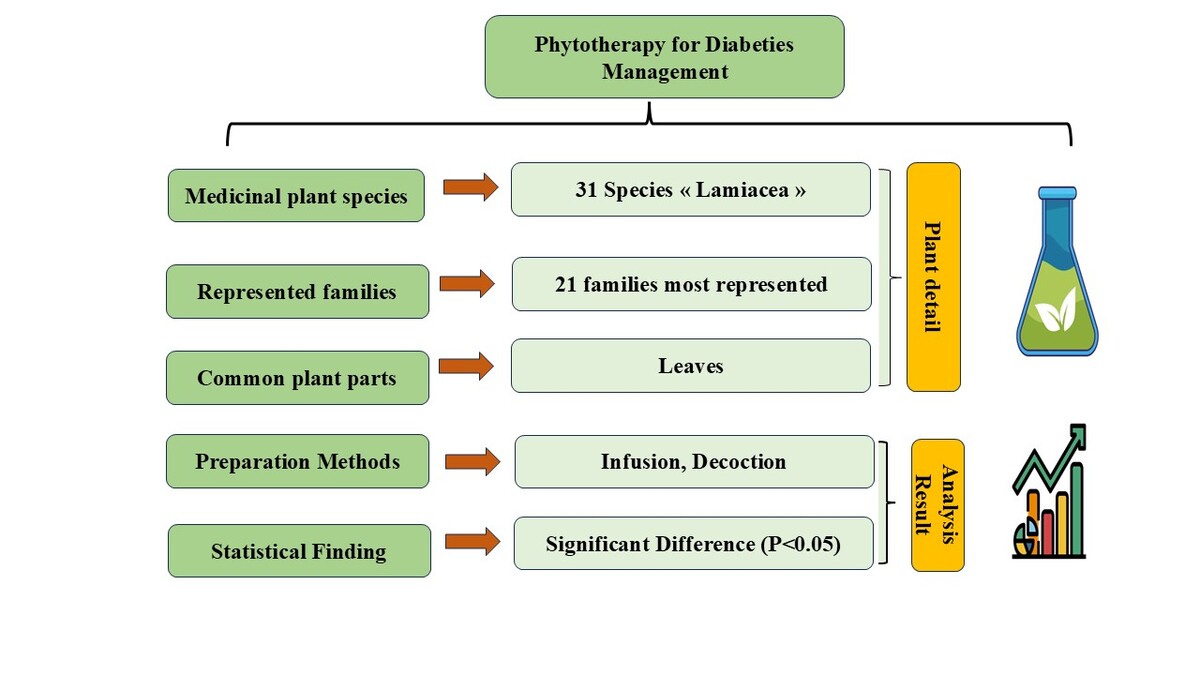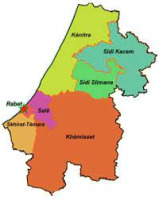Introduction
Diabetes is the greatest public health problem and is considered the silent epidemic of the 21 century (Nur et al., 2024; Vora and Kaur, 2024). It is a chronic condition characterized by hyperglycemia caused by defective insulin action, insufficient insulin secretion, or a combination of both (Rathor et al., 2024; Dmello and Bhagwat, 2024). Prolonged persistence of high blood glucose levels leads to a series of harmful complications, including psychological, physical, socio-economic, and even spiritual issues for the patient (Khumalo et al., 2021; Shahidi and Danielski, 2024; Yadav et al., 2024). Indeed, various approaches have been established for the management of diabetes, and these complications include insulin, sulfonylureas, biguanides, alpha-glucosidase inhibitors, and thiazolidinediones (Tiwari, 2015). Although these synthetic medications or artificial strategies are widely accessible for treating diabetes and its complications, these medications may have undesirable side effects (Shahzad et al., 2024; Yan et al., 2024). Furthermore, some of these conventional diabetes management approaches are often too costly, especially in poorer and developing countries (Rawal et al., 2012). Therefore, natural remedies based on conventional herbs with rich antioxidant capacity are preferably used extensively in the treatment of diabetes complications (Sachan et al., 2024; El Kamari et al., 2025). Thus, some of these patients have often consulted traditional practitioners who heavily rely on the use of herbs to manage this challenge and the associated health conditions. As a result, medicinal plants as natural resources are potential sources of new phytoactive ingredients that exhibit antidiabetic properties with fewer side effects compared to synthetic remedies for diabetes complications (Ponnusamy et al., 2011; Patle et al., 2021). Indeed, numerous research works, including those by Sudhakar et al. (2021); Jugran et al. (2021), indicate that these herbal decoctions have shown robust antioxidant potential and could reduce diabetes complications when consumed.
In Morocco, this chronic pathology remains a major public health issue, with a significant number of people affected (Mharchi and Maamri, 2023; Dankoly et al., 2023). The wealth of traditional pharmacopoeia based on the use of medicinal plants plays a considerable role in health care in the country (Chaachouay et al., 2019; EL Boullani et al., 2022). Several research works have been conducted in this context, among them, those by El Hafian et al. (2014); Doukkali et al. (2015); Douira and Zidane, (2015); Chebaibi et al. (2016). However, with the exception of a comprehensive study conducted by Salhi et al., 2010, no study has specified the use of medicinal plants to manage and reduce complications of diabetes in the city of Kénitra. Thus, the objective of the present study was to evaluate the medicinal plants used by the inhabitants of Kénitra in order to contribute to the knowledge of indigenous plants used for the treatment of diabetes. Moreover, it is very important to transform this traditional knowledge into scientific knowledge in order to enhance, preserve, and use it rationally.
Materials and Methods
Study Area
Kénitra (figure 1) is a territory defined by the latest urban development master plan, whose perimeter includes the cities of Kénitra, Mehdya, Sidi Yahia du Gharb, as well as nine surrounding rural communes. This territory extends over a total area of 1,752 km2 and has a coastline of 60 km. It is part of the geographical area commonly referred to as the Gharb plain, which includes the lower plain, the northern pre-Rif hills, and the northern edge of the Maâmora forest. This area covers approximately 7,000 km2 (Karibi and Messous, 2019).
Sampling
The study took place over 4 months (January/April) of the year 2024 at the Moulay el Hassan diabetes center in Kenitra. Direct interviews were conducted with 450 diabetic individuals to identify the medicinal plants used to manage diabetes complications. The questionnaires included personal information about the individuals affected by diabetes, the type of diabetes, the parts of the plant used, and the preparation methods. The time spent on each interview was approximately 40 minutes, and all respondents were informed about the purpose of the study. It should be noted that the participants were randomly selected to ensure the representativeness of the sample.
Calculation of the questionnaire's validity
The validity of the questionnaire was confirmed by submitting it to a group of members of the physicians at the Moulay El-Hassan primary health center in the Kénitra region in 2024, in order to gather their opinions and comments regarding the comprehensiveness of the questionnaire's dimensions, the representativeness of the statements in relation to the axes and dimensions addressed, their relevance as well as the clarity of each statement. Subsequently, the choice of responses for each of the statements was calculated. As a result, some statements were eliminated while others were modified and rephrased.
Calculation of the reliability of the questionnaire
The reliability coefficient was determined using Cronbach's alpha coefficient to evaluate the reliability of each dimension of the questionnaire as well as that of the questionnaire as a whole, as shown in tables 1 and 2.
The search for the reliability of this questionnaire shows a Cronbach index of 0.7, which indicates a reasonable reliability of the questionnaire.
Table 1
Cronbach's alpha reliability statistics
| Reliability Statistics | |
|---|---|
| Cronbach's Alpha | Number of Items |
| ,700 | 18 |
Table 2
Statistics of total items
Statistical analysis of the data
The collected data was entered and filtered in Excel and then transposed onto a SPSS (version 25.0 free) platform. Qualitative variables are expressed as percentages and quantitative variables are expressed as mean ± standard deviation. The chosen hypothesis tests are the chi-square test of independence and one-way Anova. The significance level was set at 0.05.
Results
Sociodemographic Characteristics of the Respondents
The study we conducted involved 450 respondents, of whom 76.1% (n = 343) are over 60 years old, 13.3% (n = 60) are between 50 and 60 years old, 6.4% (n = 29) are between 40 and 50 years old, 2.9% (n = 13) are between 30 and 40 years old, and 1.1% (n = 5) are under 30 years old Table 3.
Additionally, 74.7% (n = 337) are female compared to 25.1% (n = 113) who are male. Similarly, regarding educational level, 84.8% (n = 202) have primary education, 36.9% (n = 166) have secondary education, and 14% (n = 63) have higher secondary education, while participants with a university level represent only a small proportion at 14.2% (n = 19).
Regarding family status, 77.4% (n = 349) of respondents stated that they are married, compared to 13.7% (n = 62) who are single. The others reported being divorced or widowed, with percentages of 4.2% (n = 19) and 4.4% (n = 20) respectively. Furthermore, among the 450 respondents, 34.6% (n = 156) reported being unemployed. The others indicated that they hold different positions, including 4.7% (n = 21) who are students. Regarding socio-economic level, more than half of the respondents reported having a low socio-economic level, compared to 34.1% (n = 154) who reported having an average level, while only 8.2% (n = 37) reported being affluent.
Table 3
Variation of age, sex, education level, type of diabetes, and duration of diabetes according to participants' responses
Disease-related criteria
Table 4 summarizes the various disease-related criteria. Thus, according to the responses of the respondents, we distinguish two groups of types of diabetes: group 1 is characterized by type 1 diabetes (T1D), which affects 23.5% (n = 106) of those with this type of diabetes, and group 2 (T2D), which affects 76.3% (n = 344) of those with this type.
Regarding the duration of diabetes, nearly half of the respondent’s report that the duration of diabetes exceeds ten years (45.2%; n = 204), while others state that it ranges from 5 to 10 years (35.9%; n = 162), and the remainder report that the duration of diabetes does not exceed 5 years (18.6%; n = 84).
As for the type of recommended treatment, the study showed that 66.7% of respondents take oral medication, and 28.4% stabilize their diabetes through insulin injections, while 4.7% of diabetic patients follow a strict diet without treatment.
Table 4
Distribution of diabetes type, duration of diabetes, and medical treatment used according to participants' responses
Use of medicinal plants
Table 5 shows the results of yes or no responses regarding the use of medicinal plants by the respondents. Indeed, 78.9% (n = 356) reported that they use medicinal plants to manage complications related to diabetes, compared to 20.8% (n = 94) who do not.
Table 5
Distribution according to the yes or no response to the use of medicinal plants
| Item | Yes | No | Average ± Standard deviation |
|---|---|---|---|
| Use of medicinal plants | 356 (78,9%) | 94 (20,8%) | 1.2089 ± 0.40697 |
Furthermore, among this category that confirmed they use medicinal plants to alleviate complications of diabetes, we were able to identify the main plants used for this purpose (Table 6). Indeed, 33 species of medicinal plants were reported by the respondents, belonging to 21 families. The most represented family is the Lamiaceae (8 species), followed by the Myrtaceae family (3 species). The Asteraceae and Cucurbitaceae families are each represented by 2 species. The other families are each represented by only one species.
Table 6
Species used for the management of complications related to diabetes according to the participants' responses
Similarly, among the 356 individuals, or 78.9%, who report using medicinal plants, 57% (n = 257) confirm that leaves are the most commonly used part, while roots, fruits, and other parts of the plant represent only low proportions ranging from 5.8% to 9.3% (Table 7). It is noteworthy that infusion and decoction are the most commonly employed preparation methods, accounting for 39.9% and 33.5%, respectively, based on respondents' answers. Regarding the mode of administration, 60.8% of the 356 respondents confirm that they use these plants orally, while 14.4% use them for massage; only a small proportion of 3.8% indicates that this use is for rinsing. Furthermore, among the 356 individuals who report using medicinal plants, 32.8% state that they use them to reduce or prevent complications of diabetes related to vascular diseases, 19.7% declare they use them to reduce osteo-articular complications related to diabetes, 5.1% to reduce genito-urinary conditions, and 21.3% use them for other diabetes-related complications.
Table 7
Distributions of the part of the plant used, the method of preparation, the mode of administration, and the reasons for use according to the participants' responses
Similarly, the analysis of the results obtained from the chi-square test (Table 8) indicates that women (at 94.1%) tend to use medicinal plants significantly more frequently than men (at 19.5%).
Table 8
Cross-tabulation of Sex * Have you ever used medicinal plants to manage your diabetes?
Furthermore, the use of one-way ANOVA shows that there are no significant differences between the use of medicinal plants and the dependent variables such as age, academic level, and duration of diabetes. On the other hand, there is a highly significant difference between gender and the use of medicinal plants (0.000 < 0.05; F = 577.510) on one hand, and a significant difference between the type of diabetes and the use of medicinal plants (0.022 < 0.05; F = 5.243) on the other hand (Table 9). Regarding the duration of use of these plants and their frequency of use, this same analysis shows that there are no significant differences (0.819 and 0.701 > 0.05).
Table 9
Degree of significance of the different parameters according to the one-way Anova test
Discussion
In this research work, the targeted population is randomly selected and concerns individuals affected by diabetes. The studied sample is characterized by a gender ratio in favor of women (74.7%; n = 337), indicating that women tend to resort to medicinal plants significantly more often than men. This supports the conclusions of other ethnobotanical studies conducted on a national level, including that of Douira and Zidane (2015).
Moreover, the age of the majority of respondents is over 60. Indeed, as reported by several research studies including those by Douira and Zidane (2015), these elderly individuals are considered more reliable sources of information due to their possession of a significant portion of ancestral knowledge that is passed down orally. As for the academic level, nearly half of the respondents have a primary education level. This can be explained by the fact that these individuals were farmers before settling in Kénitra. The results obtained show that the majority of respondents are affected by type 2 diabetes.
Indeed, although antidiabetic medications are available on the Moroccan pharmaceutical market, the use of medicinal plants to treat, manage, and reduce complications from diabetes often proves fruitful (Kooti et al., 2016). In this regard, the surveyed population reports using a significant number of medicinal plants to treat and manage diabetes complications; for example, some plants from the Lamiaceae, Cucurbitaceae, Asteraceae, Myrtaceae, Fabaceae, Amaryllidaceae, Anacardiaceae, Apiaceae, and Apocynaceae families. This is explained by the fact that these plants have more potent hypoglycemic effects because they contain compounds such as flavonoids, tannins, phenolics, and alkaloids due to their insulinomimetic activity (Matalqah et al., 2025). Furthermore, the majority of participants in this survey state that the leaves are the most used parts when managing diabetes complications, which confirms the results obtained from numerous research works, including those by Arraji et al. (2024).
It should be noted that Hajipour et al. (2024) explain the use of medicinal plant leaves by the fact that they are the main site of photosynthetic reactions and consequently the location for the synthesis of various primary and secondary metabolic compounds of the plant. On the other hand, one-way Anova analysis shows a significant difference between gender and the use of medicinal plants (p = 0.000 < 0.05; F = 577.510) on one hand, and between the type of diabetes and the use of medicinal plants (p = 0.022 < 0.05; F = 5.243) on the other hand. However, no difference is found between the use of medicinal plants and the duration of diabetes, academic level, and age of respondents. Compared to other recently published works, the authors state that, based on their studies, the duration of diabetes, academic level, and age of respondents have significant differences (Selihi et al., 2015), which is not the case in our study.
As for the frequency of use of these plants and their duration of use, the Anova test indicates no significant differences respectively (,819>0.05; F = ,053 and ,544>; F = ,369). This can be explained by the fact that the respondents take these plants in an arbitrary manner, which can be considered a risk to their health. Indeed, as reported in several studies including those by Nchinech et al. (2024), the uncontrolled therapeutic use of medicinal plants leads to various diseases, nephrotoxicity being one of them, which is due to the regular intake of these plants, hence the need for active measures to regulate this sector (Naouaoui et al., 2020).
Conclusion
The consumption of herbs as a treatment for managing complications of diabetes remains widespread among a significant portion of the Moroccan population, due to their accessibility and low cost, while also presenting relatively low toxicity. Furthermore, it is worth noting that the use of medicinal plants is a relevant alternative to synthetic drugs. Additionally, traditional medicine continues to be widely practiced by the Moroccan population for the treatment of various ailments, including diabetes. Consequently, with the increasing interest in medicinal plants, it is essential to conduct thorough scientific research on these plants, especially regarding their frequency of use and the necessary dosage.




